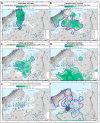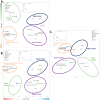The Finnic Peoples of Russia: Genetic Structure Inferred from Genome-Wide and Y-Chromosome Data
- PMID: 39766877
- PMCID: PMC11675159
- DOI: 10.3390/genes15121610
The Finnic Peoples of Russia: Genetic Structure Inferred from Genome-Wide and Y-Chromosome Data
Abstract
Background: Eastern Finnic populations, including Karelians, Veps, Votes, Ingrians, and Ingrian Finns, are a significant component of the history of Finnic populations, which have developed over ~3 kya. Yet, these groups remain understudied from a genetic point of view. Methods: In this work, we explore the gene pools of Karelians (Northern, Tver, Ludic, and Livvi), Veps, Ingrians, Votes, and Ingrian Finns using Y-chromosome markers (N = 357) and genome-wide autosomes (N = 67) and in comparison with selected Russians populations of the area (N = 763). The data are analyzed using statistical, bioinformatic, and cartographic methods. Results: The autosomal gene pool of Eastern Finnic populations can be divided into two large categories based on the results of the PCA and ADMIXTURE modeling: (a) "Karelia": Veps, Northern, Ludic, Livvi, and Tver Karelians; (b) "Ingria": Ingrians, Votes, Ingrian Finns. The Y-chromosomal gene pool of Baltic Finns is more diverse and is composed of four genetic components. The "Northern" component prevails in Northern Karelians and Ingrian Finns, the "Karelian" in Livvi, Ludic, and Tver Karelians, the "Ingrian-Veps" in Ingrians and Veps (a heterogeneous cluster occupying an intermediate position between the "Northern" and the "Karelian" ones), and the "Southern" in Votes. Moreover, our phylogeographic analysis has found that the Y-haplogroup N3a4-Z1927 carriers are frequent among most Eastern Finnic populations, as well as among some Northern Russian and Central Russian populations. Conclusions: The autosomal clustering reflects the major areal groupings of the populations in question, while the Y-chromosomal gene pool correlates with the known history of these groups. The overlap of the four Y-chromosomal patterns may reflect the eastern part of the homeland of the Proto-Finnic gene pool. The carriers of the Y-haplogroup N3a4-Z1927, frequent in the sample, had a common ancestor at ~2.4 kya, but the active spread of N3a4-Z1927 happened only at ~1.7-2 kya, during the "golden" age of the Proto-Finnic culture (the archaeological period of the "typical" Tarand graves). A heterogeneous Y-chromosomal cluster containing Ingrians, Veps, and Northern Russian populations, should be further studied.
Keywords: Finnic people; Ingrian Finns; Ingrians; Karelians; Veps; Votes; Y-chromosome; ancestral components; gene pool; genome-wide SNPs.
Conflict of interest statement
The authors declare no conflicts of interest.
Figures






References
-
- Klementyev E.I., Shlygina N.V. The Baltic Finnic Peoples of Russia. Nauka; Moscow, Russia: 2003. (In Russian)
-
- All-Russian Population Census 2020. [(accessed on 29 August 2024)]; Available online: https://rosstat.gov.ru/vpn/2020/Tom1_Chislennost_i_razmeshchenie_naseleniya.
-
- Laakso J. Finnic: General introduction. In: Bakró-Nagy M., Laakso J., Skribnik E., editors. The Oxford Guide to the Uralic Languages. Oxford University Press; Oxford, UK: 2022. pp. 240–252. - DOI
-
- Saarikivi J. The divergence of Proto-Uralic and its offspring: A descendent reconstruction. In: Bakró-Nagy M., Laakso J., Skribnik E., editors. The Oxford Guide to the Uralic Languages. Oxford University Press; Oxford, UK: 2022. pp. 28–58. - DOI
-
- Lang V. Stone Age Cultural Changes in Our Interpretations of Ethnic History. In: Björklöf S., Jantunen S., Junttila S., Kuokkala J., Laitinen S., Pasanen A., editors. Itämeren kieliapajilta Volgan verkoille: Pühendusteos Riho Grünthalile 22. mail 2024. Suomalais-Ugrilainen Seura; Helsinki, Finland: 2024. [Suomalais-ugrilaisen seuran toimituksia, 278]
MeSH terms
Grants and funding
LinkOut - more resources
Full Text Sources

